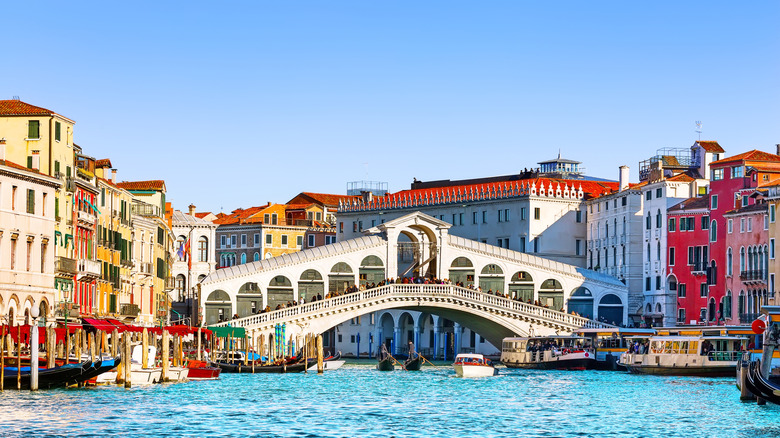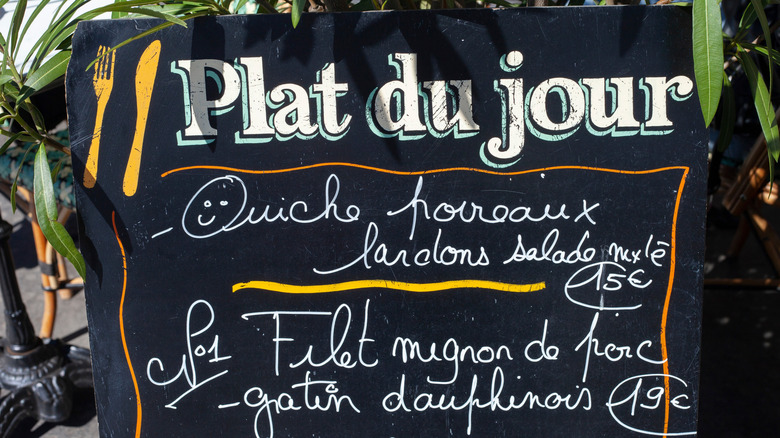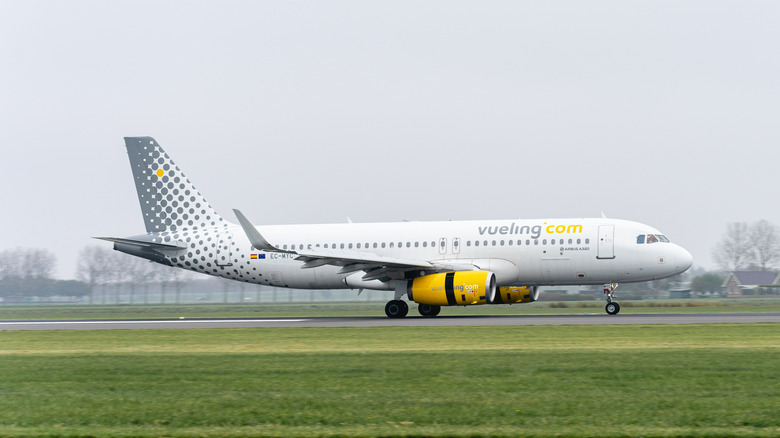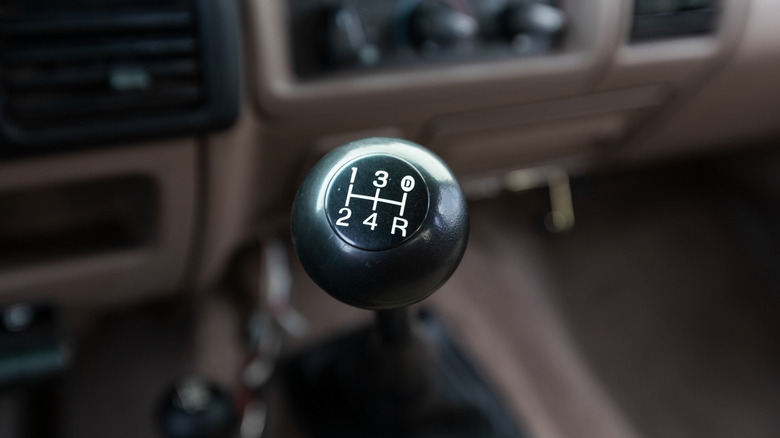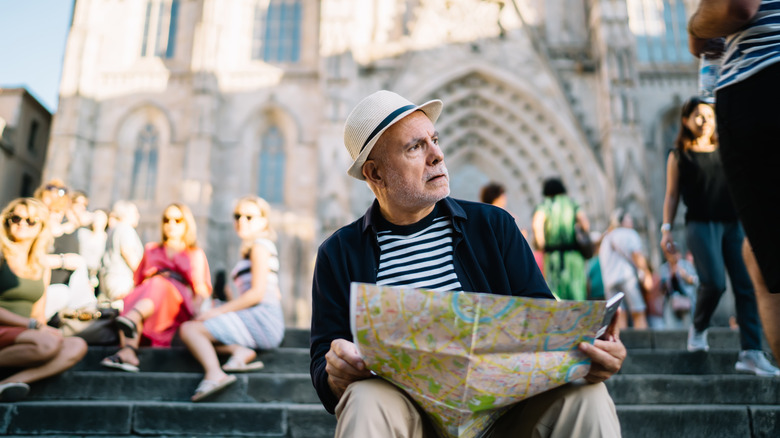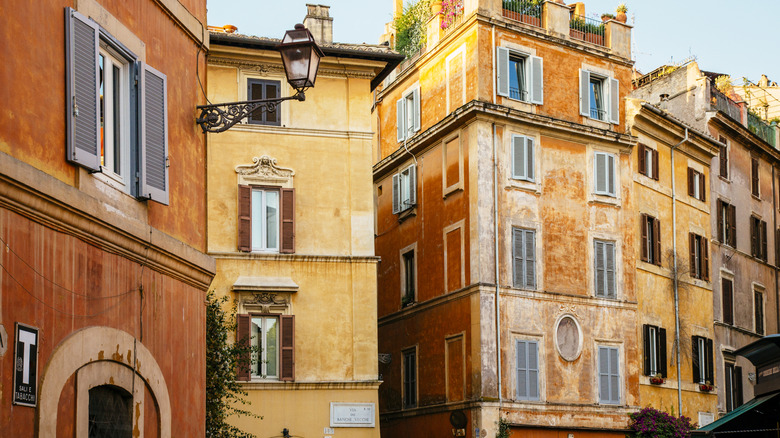The Ultimate 'Survival Guide' For A European Vacation
America may have been founded by Europeans, but to paraphrase Thomas Jefferson, Americans pride themselves on having ditched the old continent in virtually every way possible — and it shows. American tourists might find visiting Europe's kaleidoscope of countries for the first time a culture shock in itself, even though in many cases their ancestors came from those places. Given this is enough of a challenge, no one wants to face logistical problems that will complicate an already stressful trip.
Europe is a diverse place, and each country has its own laws and customs when dealing with foreigners, but there are still a few broad trends that any tourist should know. Some apply across countries, some only to certain parts of Europe, but they will help any newbie adjust to local behavior, interact with locals on their terms (remember, you're a guest), and save money. From navigating restaurant culture, inter-country travel, and local niceties, here is a basic survival guide that any first-time American visitor to Europe will find invaluable to enjoying the rich history the old continent has to offer.
Don't expect kids' menus
Families with small children, take note: European countries, especially the most popular ones–places like Italy, Spain, and France–don't tend to have kids menus. In these countries, eating well and having a varied palate is considered a part of the national culture, and children are expected to more or less eat the same things adults do. Thus, if traveling with small children, do not expect restaurants to cater to expectations of chicken nuggets and French fries as American restaurants do. In Eastern Europe, you're even less likely to find that kind of stuff.
For families with picky eaters, there is no easy solution. Apart from trying to introduce children to the kinds of foods they might face in the European destination of choice, there isn't much else to do apart from picking restaurants strategically to ensure they have something children might like. In places like Italy, some restaurants might be willing to make children the local version of a kids' meal, which would be something like pasta with meat sauce. But again, don't walk in expecting that, because it's up to the staff's discretion.
The major exception to the trend is Scandinavia. In Sweden, for instance, Travel + Leisure writer Kathryn Romeyn reported separate kids' menus with offerings like Swedish meatballs with gravy and lingonberries as well as potato-rich meals–all typical Swedish foods that still give children a local culinary experience without a potential tantrum. A menu from Norway is more traditional, featuring things like pasta and hamburgers.
American-style tipping isn't a thing
Tipping in Europe is nothing like in the United States, where waiters expect a minimum of 15% behind for standard service, and up to 25% for exceptional service. In Europe, the highest you might be looking at is 15%. There isn't a blanket rule, but a good measure is 10%–if you feel like it. It's not expected nor will you be guilted into leaving anything, because European waiters are generally better paid than their American counterparts. The same rule generally applies to taxi drivers, while valets get anything from 2-5 euro per luggage. For exceptional service, feel free to leave more.
A few countries have some minor particulars worth noting. In Croatia, especially in the tourist destinations of the Dalmatian coast, it is customary to round up your bill to the nearest 10 when paying in cafes and bars. In Germany and Austria, the customary amount can go up to 15%, but that is the ceiling, unlike in the United States, where it's the floor. Finally, southern Italians, whose culture places a premium on personal honor and integrity with guests, may even reject tips–a Puglian taxi driver I had even seemed offended that it was offered. That said, in larger cities, there's a reason European service workers like American tourists-–life in Europe is expensive and few are going to turn down a 20% tip if given the chance.
Take the train
Europe is small. The old continent's major tourist destinations would fit inside the United States, with plenty of room to spare. Coupled with the fact that cities were built for people rather than cars has resulted in a fairly efficient public transportation system that puts America to shame. So don't be afraid to take buses and trains within and between cities — it can save you a lot of money, especially if you are traveling light.
The benefits of European train travel are legion. Within cities, subways provide a quick and cheap way to get between major sites. Intercity train travel means no airport security line or check-in–just show up, buy your ticket to wherever (including another country), and board. Just be aware that there are both regional and national lines. So if you are in Italy and want to go from a town like Laveno-Mombello to Rome, you have to change train lines in Milan.
There are, of course, drawbacks. Train travel — even on high-speed rails — takes time. You can travel across Italy by plane in a few hours, whereas to go from Milan to Reggio Calabria in the toe of the peninsula is around 13 hours. But regardless of which country you're in, you will get some gorgeous scenery.
As for crime, pickpockets and scammers are probably your biggest daytime issue, so follow the usual common-sense rules: Don't draw attention to yourself, flash valuables, or hang around major urban stations at night.
Take advantage of low cost flights
Trains may not be financially worth it or logistically possible. Taking a 15-hour train ride between two European capitals with a lot of luggage or children isn't worth it given cost-complications ratio. Fortunately, Europe has tons of budget airlines that make getting around in a breeze very cheap–we're talking as low as $30 according to travel guru Rick Steves.
The most famous budget European airline is RyanAir, but there is also Vueling in Spain, the UK's EasyJet, EuroWings, and many, many others, all of which vary drastically in quality, conditions of carriage, and fees. According to Travel & Leisure these average out to nearly $300 extra if you're not careful. So, as a traveler, be cautious of a few things on these budget carriers. First, traveling light is best for such flights. Most give you one carry-on and one personal item–anything more will cost you. Second, these airlines tend to have strict conditions of carriage. That means no flexibility and often, few to no complimentary extras (RyanAir even charges for water). Ergo, don't buy the ticket until your plans are set in stone. Third: know the extras. While you can refuse food and drinks on board, you can't simply ditch your larger luggage. Checked bags fees can hit up to $80 for your standard 50 lb bag.
Finally, some of these low-cost airlines' aircraft are not exactly the most comfortable. But since these flights are usually only 2-3 hours, it's worth it-–just do your research, plan accordingly, and don't expect the PanAm treatment.
Rent a stick shift to save money
Stick shifts are basically an anti-theft devices in America because no-one uses them. In Europe, a money saver. European speed limits are lower, cities are more crowded, and roads are narrow and often not straight. In that situation, responding quickly to changing circumstances makes a manual a better option over an automatic, whereas on the open highways of America, an automatic is preferable for keeping cruising speed.
Thanks to these market supply-and-demand forces, automatic rental cars are much more expensive in Europe–-sometimes twice as much as a stick shift–since American tourists are the only ones who get them. For European companies, it is not worth keeping cars that cost more to maintain and insure for this single group of tourists. So, if you are traveling on a budget but need a car–perhaps you are staying in a rural area or traveling with children, who tend to bring a lot of luggage–your wallet will thank you if you take a few stick shift lessons. If you don't want to go back to driving school, ask an older friend or relative. It doesn't take long to get used to a stick shift. If you rent an automatic, be aware that Europe's low speed limits will make you much more vulnerable to being fined for speeding should you happen to run into a dreaded speeding camera in places like Italy — even for just a few miles over the limit.
If crossing borders, check local driving laws and regulation
Do not assume all European driving is the same! While driving in the big destinations of France, Spain, the UK, and Italy is pretty straightforward, Central Europe is another ballgame, who penalty for losing is (for Americans) an unusual fine. Eight countries in this region require all drivers to have a sticker called a vignette affixed to the windshield to drive on their open-road highways.
Now here's the kicker: Drivers must have the vignette before entering the country that requires it. Take the example of crossing from Italy to Slovenia: Slovenian law requires a vignette to drive on highways. Let's say, like so many tourists, you are heading to Croatia. You will likely enter Slovenia by highway near Koper-Capodistria, likely without even noticing the exact moment in which you cross, because in the Schengen area, there are no passport controls. Thus, you must have the vignette before entering Slovenia. If you cross that border without it, even if you didn't notice or meant to buy it later, Slovenian police will be there, armed with credit card readers, to slap you with a fine that can reach up to 800 euros.
While fines in other countries are not as high, it's still a waste of money, especially for something so easily avoidable with a little foresight. Fortunately, countries like Slovenia have made things easier with an e-vignette on your phone that links to your license plate and gives peace of mind lest you forget to buy the sticker.
Be prepared to convert euros in non-eurozone countries
The European Union and the Eurozone are two different things. While the euro is accepted in virtually every major Western European country (except the UK), it won't always be of use in Eastern Europe and Scandinavia, where local currencies such as the Polish zloty, Czech crown, Swedish and Danish krona/kroner, and Romanian leu are legal tender. Serbia uses the dinar while Bosnia uses the mark. The rationale is the maintenance of financial independence, but since many of these countries are economically poorer, they benefit from receiving remittances from expats working in the Eurozone.
In such countries, tourists should be prepared to convert a few euros or dollars to local currency upon arrival. Informal local merchants, like artisan roadside stands or food stands in countries like Romania, Bulgaria, or Poland might accept Euros, but will offer an inferior conversion rate that favors their business. Stores, however, will almost always insist on payments in local currency, which actually works in your favor, given the Euro's strength against, say, the Leu or the zloty.
Finally, two things to keep in mind. First: Switzerland, which is neither part of the EU nor the Eurozone, is an exception. Swiss law permits businesses to accept Euros, but there is no legal obligation to do so. Switzerland, however, has a highly developed tourist sector closely tied to the Eurozone, so most businesses in major cities accept euros. However, any change will be in Swiss Francs. Second: Croatia adopted the Euro in 2023, so tourists no longer need to convert euros to kunas.
DO NOT insert yourself into local politics
If you're visiting Eastern Europe as a short-term tourist and local politics or religion come up, keep your mouth shut. The wounds of war run deep here and ethno-religious relations are still sometimes tense. Memories of the Yugoslav wars — marked by ethnic cleansing, violence, and displacement — are still fresh for many. Most victims on all sides were innocent civilians who won't take kindly to being lectured about "good" versus "bad."
Russia's role is also complex, most recently due to the ongoing war in Ukraine and the history of Soviet occupation. According to surveys from the Chicago Council on Global Affairs, locals likely won't welcome expressions of admiration for Vladimir Putin, even if you oppose Russia's actions. Older generations, especially in Ukraine and the Baltic, carry memories Red Army atrocities during World War II, like mass rapes, genocide, summary executions, and more. Thus, Russia's role in the region is not viewed positively, contra the simplistic American narrative of Russia as a liberator in World War II or conservative narratives that paint Russia's Ukrainian adventure as self-defense.
If the topic does come up, listen, ask well-meaning questions, don't press if the person doesn't want to talk, and most importantly, don't argue. Their stories will likely challenge your assumptions (and possibly offend your sensibilities). But they will also enrich your trip by giving you nuanced historical and cultural perspectives on painful and sensitive topics—the kind of memories you will carry for life.
Don't be afraid to get a guide
Europe may be small, but it's diverse. With 24 national languages and many more regional languages from at least four different language families, you won't be able to learn every single country's language–at least not enough to get to know the less touristy areas where English is rarer. The solution? Get a guide.
Guides are expensive in Western Europe, but decrease as you go eastward. Neverthelesw, Rick Steves recommends splurging because guides are often lifelong locals with deep knowledge and personal perspectives on the destination, which holds a dear place in their hearts. Want to hear the legend of the Venetian battle flag in Perast and the hidden gem church of St. Nicholas? Or find out what it was like to be on the front lines of Romania's anticommunist protests in 1989? Or maybe find out about a local artist in Rovinj, Croatia, who helps renovate local churches? These are the hidden gems guides will help you find — not to mention free attractions, even in major cities like Rome.
In Eastern Europe, especially outside the major tourist centers, English is less common. Due to the language barrier and cultural differences, it's worth getting a guide from a purely practical perspective. He can teach you local manners, link you up with find the best food and experiences, do the talking for you, and introduce you to locals as a translator. Just make sure he is registered with the national tourism board–you don't want to get scammed, or worse.
Rent an apartment
Hotels are great for short, 2-3-day stays in major European cities. Anything longer quickly gets expensive, particularly for travelers with children and large families. Fortunately, Europe is packed full of short-term rentals, ranging from apartments to houses and even villas if you really want to splurge.
The benefits of renting an apartment are not just financial. Having your own place will give you a taste–however small–of what local life is like. For example, renting an apartment or house in Italy will allow you to shop at Italian grocery stores, which carry cheap, natural, high-quality food on par with USDA Organic. This is the situation in pretty much every European country with a strong culinary tradition, like Spain, France, and Portugal. Parents of picky eaters can also give their children a homemade taste of local cuisine at their own pace, rather than the stress of finding something at a restaurant.
For tourists seeking a vacation in more rural areas, hotels aren't even an option. If you want to stay in the Tuscan wine country or the mountains of Asturias, you will need to rent a place of your own, usually an old farm-turned-lodging. In Italy, these are usually called agriturismi, although each country has its own variant. If you're willing to pay a bit more, you can rent one that produces goods like wine and olive oil, which the owners might even give you as a gift, along with tasting tours and other perks that make these regions so special.
AC is often not a thing
America: land of the free and of AC. Air conditioning is ubiquitous in America. Many born after 1970 probably don't remember life without it–so much it is almost considered an addiction. So imagine the shock when Americans visit Europe in the stifling summer heat only to find their lodging lacks AC.
European houses don't have AC for a couple of reasons. The old continent tends to have higher energy costs thanks to environmental regulations that make AC too expensive to run. Older European homes, which predate air conditioning, are built out of temperature-regulating materials such as stone, whose high thermal mass allows it to absorb heat more slowly. In Greece, houses are painted white to reflect the heat of the sun.
If you are staying in places like Southern Italy, Greece, and Southern Spain, where temperatures can regularly hit 100℉, don't fear not having AC. The houses don't tend to get sweltering–after all, people have lived in them for centuries. That said, Americans, who tend to keep their homes between 68-70℉ degrees, may find them uncomfortably hot at ~76℉. Instead of reminding you about your grandparents' calling you a wimp, here are a few ways to beat the heat: keep windows open at night–cross-breezes are best–and keep a bedside fan running to keep air moving. Many properties will provide one. Cold baths or showers before bed won't hurt as does sleeping in light clothes. Otherwise, do as the locals do. In Southern Italy, for instance, it is not uncommon to go for a passeggiata in city centers as late as 8 p.m. and then stay up until 1 a.m. chatting with neighbors. Southern Spain is similar.
